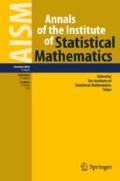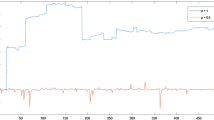Abstract
A direct method for multistep prediction of a stationary time series involves fitting, by linear regression, a different autoregression for each lead time, h, and to select the order to be fitted, % MathType!MTEF!2!1!+-% feaafeart1ev1aaatCvAUfeBSjuyZL2yd9gzLbvyNv2CaerbuLwBLn% hiov2DGi1BTfMBaeXafv3ySLgzGmvETj2BSbqefm0B1jxALjhiov2D% aebbfv3ySLgzGueE0jxyaibaiGc9yrFr0xXdbba91rFfpec8Eeeu0x% Xdbba9frFj0-OqFfea0dXdd9vqaq-JfrVkFHe9pgea0dXdar-Jb9hs% 0dXdbPYxe9vr0-vr0-vqpWqaaeaabiGaaiaacaqabeaadaqaaqGaaO% qaaiqadUgagaacamaaBaaaleaacaWGObaabeaaaaa!3E44!\[\tilde k_h\], from the data. By contrast, a more usual ‘plug-in’ method involves the least-squares fitting of an initial k-th order autoregression, with k itself selected by an order selection criterion. A bound for the mean squared error of prediction of the direct method is derived and employed for defining an asymptotically efficient order selection for h-step prediction, h > 1; the S h(k) criterion of Shibata (1980) is asymptotically efficient according to this definition. A bound for the mean squared error of prediction of the plug-in method is also derived and used for a comparison of these two alternative methods of multistep prediction. Examples illustrating the results are given.
Similar content being viewed by others
References
Akaike H. (1970). Statistical predictor identification, Ann. Inst. Statist. Math., 22, 203–217.
Akaike H. (1973). Information theory and an extension of the maximum likelihood principle, 2nd International Symposium on Information Theory (eds. B. N. Petrov and F. Csaki), 278–291, Akademia Kiado, Budapest.
Anderson T. W. (1971). The Statistical Analysis of Time Series, Wiley, New York.
Baxter G. (1963). A norm inequality for a “finite-section” Wiener-Hopf equation, Illinois J. Math., 7, 97–103.
Bhansali R. J. (1981). Effects of not knowing the order of an autoregressive process on the mean squared error of prediction—I, J. Amer. Statist. Assoc., 76, 588–597.
Bhansali R. J. (1986). Asymptotically efficient selection of the order by the criterion autoregressive transfer function, Ann. Statist., 14, 315–325.
Bhansali R. J. (1993). Estimation of the prediction error variance and an R 2measure by autoregressive model fitting, J. Time Ser. Anal., 14, 125–146.
Bhansali R. J. and Downham D. Y. (1977). Some properties of the order of an autoregressive model selected by a generalization of Akaike's FPE criterion, Biometrika, 64, 547–551.
Bhansali R. J. and Papangelou F. (1991). Convergence of moments of least-squares estimators for the coefficients of an autoregressive process of unknown order, Ann. Statist., 19, 1155–1162.
Box G. E. P. and Jenkins G. M. (1970). Time Series Analysis: Forecasting and Control, Holden Day, San Francisco.
Brillinger D. R. (1975). Time Series: Data Analysis and Theory, Holt, New York.
Cox D. R. (1961). Prediction by exponentially weighted moving averages and related methods, J. Roy. Statist. Soc. Ser. B, 23, 414–422.
del Pino G. E. and Marshall P (1986). Modelling errors in time series and k-step prediction, Recent Advances in Systems Modelling (ed. L. Contesse), 87–98, Springer, Berlin.
Findley D. F. (1983). On the use of multiple models for multi-period forecasting, Proceedings of the Business and Economic Statistics Section, 528–531, American Statistical Association, Washington, D.C.
Gersch W. and Kitagawa G. (1983). The prediction of a time series with trends and seasonalities, Journal of Business and Economic Statistics, 1, 253–264.
Greco C., Menga G., Mosca E. and Zappa G. (1984). Performance improvements of self-tuning controllers by multistep horizons: the MUSMAR approach, Automatica, 20, 681–699.
Grenander U. and Rosenblatt M. (1954). An extension of a theorem of G. Szego and its application to the study of stochastic processes, Trans. Amer. Math. Soc., 76, 112–126.
Hurvich C. M. (1987). Automatic selection of a linear predictor through frequency domain cross validation, Comm. Statist. Theory Methods, 16, 3199–3234.
Kabaila P. V. (1981). Estimation based on one step ahead prediction versus estimation based on multi-step ahead prediction, Stochastics, 6, 43–55.
Lewis R. and Reinsel G. C. (1985). Prediction of multivariate time series by autoregressive model fitting, J. Multivariate Anal., 16, 393–411.
Lin J.-L. and Granger C. W. J. (1994). Forecasting from non-linear models in practice, Journal of Forecasting, 13, 1–9.
Milanese M. and Tempo R. (1985). Optimal algorithms theory for robust estimation and prediction, IEEE Trans. Automat. Control, AC-30, 730–738.
Pillai S. U., Shim T. I. and Benteftifa M. (1992). A new spectrum extension method that maximizes the multistep minimum prediction error-generalization of the maximum entropy concept, IEEE Transactions on Signal Processing, 40, 142–158.
Priestley M. B. (1981). Spectral Analysis and Time Series Academic Press, New York.
Ray B. K. (1993). Modeling long-memory processes for optimal long-range prediction, J. Time Ser. Anal., 14, 511–526.
Shibata R. (1980). Asymptotically efficient selection of the order of the model for estimating parameters of a linear process, Ann. Statist., 8, 147–164.
Shibata R. (1981). An optimal autoregressive spectral estimate, Ann. Statist., 9, 300–306.
Stoica P. and Nehorai A. (1989). On multistep prediction error methods for time series models, Journal of Forecasting, 8, 357–368.
Stoica P. and Soderstrom T. (1984). Uniqueness of estimated k-step prediction models of ARMA processes, Systems Control Lett., 4, 325–331.
Tiao G. C. and Xu D. (1993). Robustness of MLE for multi-step predictions: the exponential smoothing case, Biometrika, 80, 623–641.
Wall K. D. and Correia C. (1989). A preference-based method for forecasting combination, Journal of Forecasting, 8, 269–292.
Wei W. W. S. (1990). Time Series Analysis, Addison Wesley, Redwood City.
Weiss A. A. (1991). Multi-step estimation and forecasting in dynamic models, J. Econometrics, 48, 135–149.
Whittle P. (1963). Prediction and Regulation by Linear Least-Square Methods, English University Press, London.
Yamamoto T. (1976). Asymptotic mean square prediction error for an autoregressive model with estimated coefficients, Applied Statistics, 25, 123–127.
Author information
Authors and Affiliations
About this article
Cite this article
Bhansali, R.J. Asymptotically efficient autoregressive model selection for multistep prediction. Ann Inst Stat Math 48, 577–602 (1996). https://doi.org/10.1007/BF00050857
Received:
Revised:
Issue Date:
DOI: https://doi.org/10.1007/BF00050857




